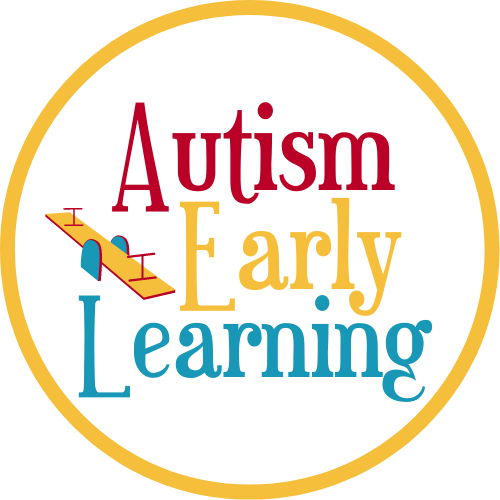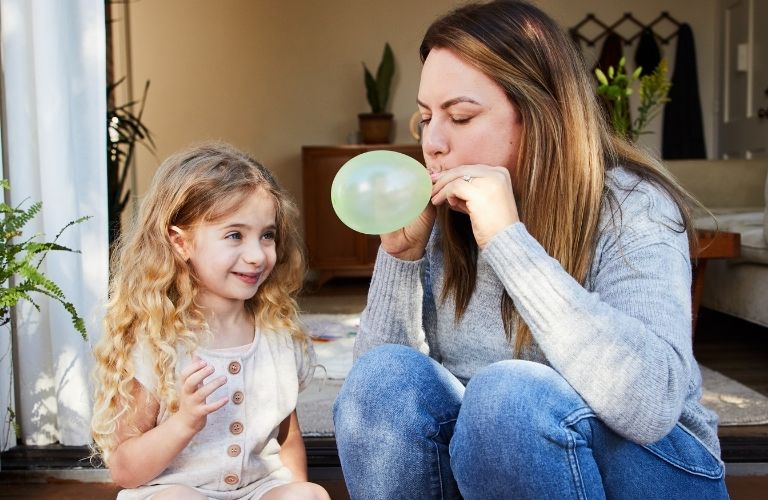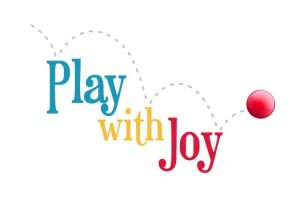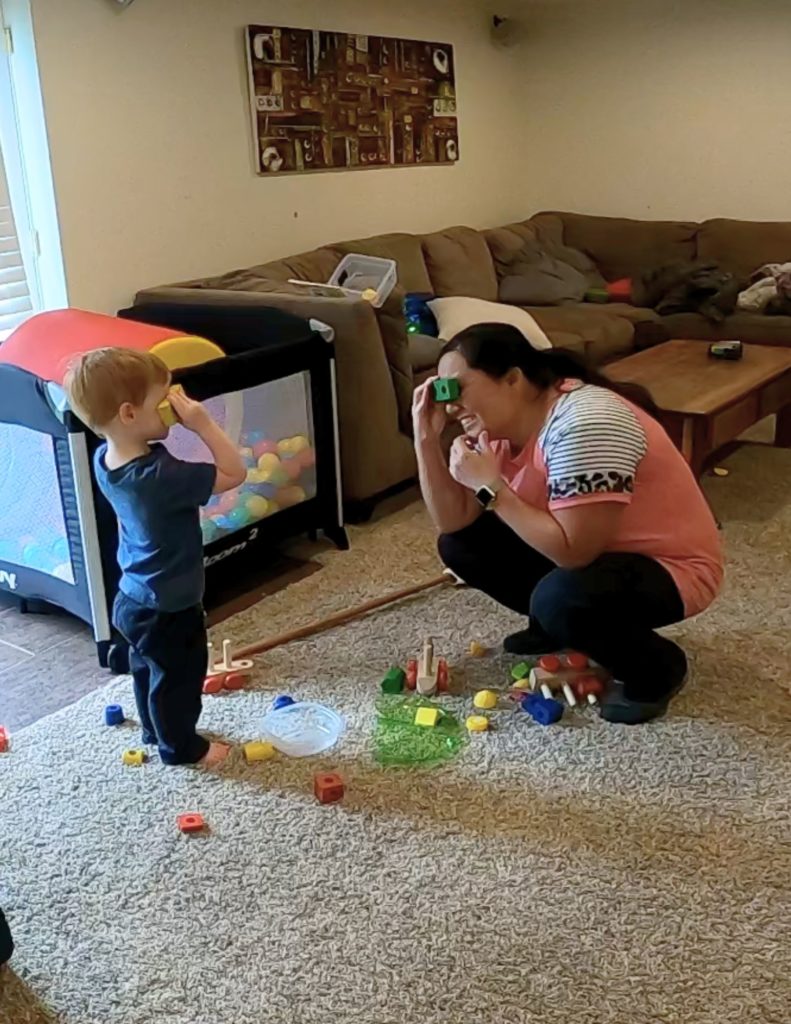Balloons are a great early intervention activity because you can target so many different developmental skills. Whether you’re working on engagement, attention, communication skills, or motor skills you can get a lot out of this simple activity.
In this post, I’m going to focus on communication skills, however if you’re interested in learning more about adapting this activity to target other skills, you can learn how you can become a member of the Early Intervention Tutorials and gain access to this and many other activities and techniques.
Receptive Language
Receptive language is being able to understand language. When you’re working on receptive language in a more structured way, it may sound like this “find red” or “give me the pig.” It’s the ability of the child to understand what a word means.
I’m going to show you some ways to work on the same skill in a more playful and natural way.
- Salient language
- An easy way to work on receptive language is to use a lot of salient language. For kids who are not using more than 1-2 word sentences independently, emphasize certain words. For example, you might say things like “balloon” “red balloon” “ready, set, go!” “fly” “more” “bigger” Just narrate as you go. Model language for your child.
- Teaching body parts
- Let’s say you’re working on body parts. Instead of just saying “where’s your hands?” you can get a balloon, blow it up and start blowing air on different body parts. As you’re letting air out you can say “I’m going to get your hair!” and then “I’m going to get your hands”
- After you’ve set up this sequence, then start to pause. You’ll be looking for your child to either move move that body part away or towards you. So if you say “I’m going to get your ear!” and your child covers her ears, then you know she’s understanding what you’re saying. Also if she puts her ear to you for you to do it, you know she’s understanding.
- My and Yours. With the same game of blowing the air on your body, you can practice “my hand” and “your hand” then “my hair” and “your hair”
- Following directions
- For kids who are able to follow directions, work on simple one step or multi-step directions
- If you’re working on circles of communication, don’t give too many instructions.
- If you’re specifically working on following directions, then go ahead and give simple one or multi-step directions. For example, “get the balloon” “give me the red balloon” “where did it go?” “kick it” “hit it” “pass it to me” etc.
Expressive Language
Expressive language is using words, gestures, or writing to express oneself. I’m going to give you some tips on working with kids that are in the beginning stages of being able to initiate or say simple words.
- Opening circles of communication.
- Set up a simple sequence. For example, blow up a balloon and let it fly. Go get it, then blow it up and let it fly again. Do this 3-4 times until you know your child is engaged and having fun.
- Once the sequence is established, pause and wait for your child to initiate for it to go (expectant waiting). This can be through a word, a gesture, or eye contact. Whatever it is, take it as communication (if you’re working on communication, don’t discount your child’s attempt at communicating just because it’s not how you wan your child to communicate), give it a word, and let the balloon go.
- You can also use expectant waiting after the balloon flies and wait for your child to go get it without telling your child to go get it. When your child goes and gets the balloon and brings it to you, this is a big opening of a circle.
- Add a 1,2,3 Go sequence whether it’s when you’re blowing up the balloon or letting the balloon fly. Pause right before “go” and wait for your child to initiate for you to go.
- Use playful obstruction by playing dumb or doing the wrong thing in order to get more circles.
- Act like you can’t find the balloon after if flies away, and make looking for the balloon it’s own activity. You could say “balloon, balloon where are you?” this is a way to model language.
- Find the wrong things and try to blow them up like a balloon, get silly.
- When your child hands you the balloon to blow it up, put it on your head or try to blow it up from the wrong side. See if your child will correct you (this is another circle).
These are just a few examples of early intervention activities you can do to work on language and communication. As kids progress, you can adapt the activity to the skills they’re currently working on if this is a high interest activity. Get creative and find as many ways you can play with a balloon as possible (this is called Theme and Variation). Have fun, and share some of your ideas, I’d love to hear them!
This activity is great for kids at an FDL of: 1-6
The Functional Developmental Levels (FDL) are based on The PLAY Project. If you would like to learn more about The PLAY Project, please visit playproject.org.
- FDL 1: Self Regulation & Shared Attention
- FDL 2: Engagement & Relating
- FDL 3: Intentionality & Two-Way Communication
- FDL 4: Social Problem-Solving & Mood Regulation
- FDL 5: Creating Symbols & Using Words & Ideas
- FDL 6: Emotional Thinking, Logic & Sense of Reality
This activity is great for kids primarily participating in stages: 1-6
The Stages of Play come from Parten’s Stages of Social Play.
- Stage 1: Unoccupied Play
- Stage 2: Solitary Play
- Stage 3: Onlooker Play
- Stage 4: Parallel Play
- Stage 5: Associative Play
- Stage 6: Cooperative Play
This activity includes: Vestibular, Proprioceptive, Tactile
Our senses include more than the usual 5 senses. Some kids may seek certain types of sensory input and/or avoid other types.
- Visual: Sight
- Auditory: Sound
- Olfactory: Smell
- Oral: Taste (Gustatory) and using the mouth to speak, make sounds, eat, chew, drink, etc.
- Tactile: Touch
- Vestibular: How we process information about movement, gravity, and balance. We receive this information through the inner ear.
- Proprioceptive: How we process information about body position and body parts. We receive this information through our muscles, ligaments, and joints.
This activity is good for targeting the following developmental skills: communication, cognitive, executive functioning, motor, social-emotional
These are the main areas of child development addressed in the Early Intervention Tutorials
- Communication: receptive language, expressive language, listening, two-way communication
- Cognitive skills: cause & effect, literacy, math, science, problem solving, perception and concept
- Executive functioning: emotional control, flexibility, perseverance, self-monitoring, organization, planning, response inhibition, attention, task initiation, time management, working memory
- Motor skills: fine motor, gross motor, perceptual motor
- Social-emotional skills: peer interaction, self concept & social role, pretend play, behavior, group activities
- Adaptive skills: self-care, personal responsibility
Supplies
- Balloon
Instructions
- There are a lot of different ways to play with a balloon. Check out the sections below for more specifics.
- Play catch with a balloon
- Blow it up and let it fly
- Make a funny noise with the balloon
- Don’t let the balloon touch the ground
Extra Tips & Ideas
- First decide what your goals are before deciding how to play with the balloon
- If you’re working on opening and closing circles, then choose a cause and effect type of activity.
- If you’re working on cooperative play, choose a game like don’t let the balloon touch the ground
- See more ideas in the following sections.
Access The Full Tutorial
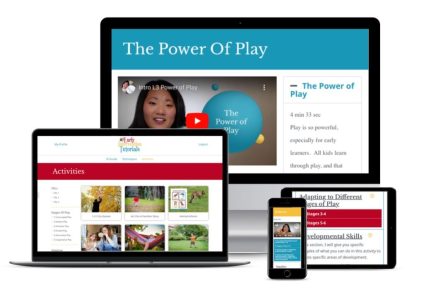
To gain full access to this tutorial and 70+ other activity and technique tutorials, become a member of The Early Intervention Tutorials
As a member of the EI Tutorials, you will learn how to:
- Identify a child’s developmental level
- Understand the stages of play
- Learn how to help a child with limited play skills
- Implement specific techniques to increase communication and engagement
- Adapt activities to different stages of development
- Target specific developmental skills, including: communication skills, cognitive skills, executive functioning, motor skills, social skills, and adaptive skills
Adapting to Different Stages of Play
Depending on a child’s stage of development, you’ll want to adapt this activity based on goals that would be appropriate for the child’s growth.
The stages of play are:
- Stage 1: Unoccupied Play
- Stage 2: Solitary Play
- Stage 3: Onlooker Play
- Stage 4: Parallel Play
- Stage 5: Associative Play
- Stage 6: Cooperative Play
I’ll share ideas on how to do this in the Early Intervention Tutorials. You can become a member and gain access to this tutorial by going to: https://autismearlylearning.com/ei-tutorials-info/
Developmental Skills
In this section, I’ll identify which areas of development this activity targets. I’ll also give some pointers on how to specifically target each area. You can become a member of the Early Intervention Tutorials by going to: https://autismearlylearning.com/ei-tutorials-info/
Download
- Printable Lesson Plan (only available in the Early Intervention Tutorials)
Links
As an Amazon Associate, I earn from qualifying purchases at no cost to you.
